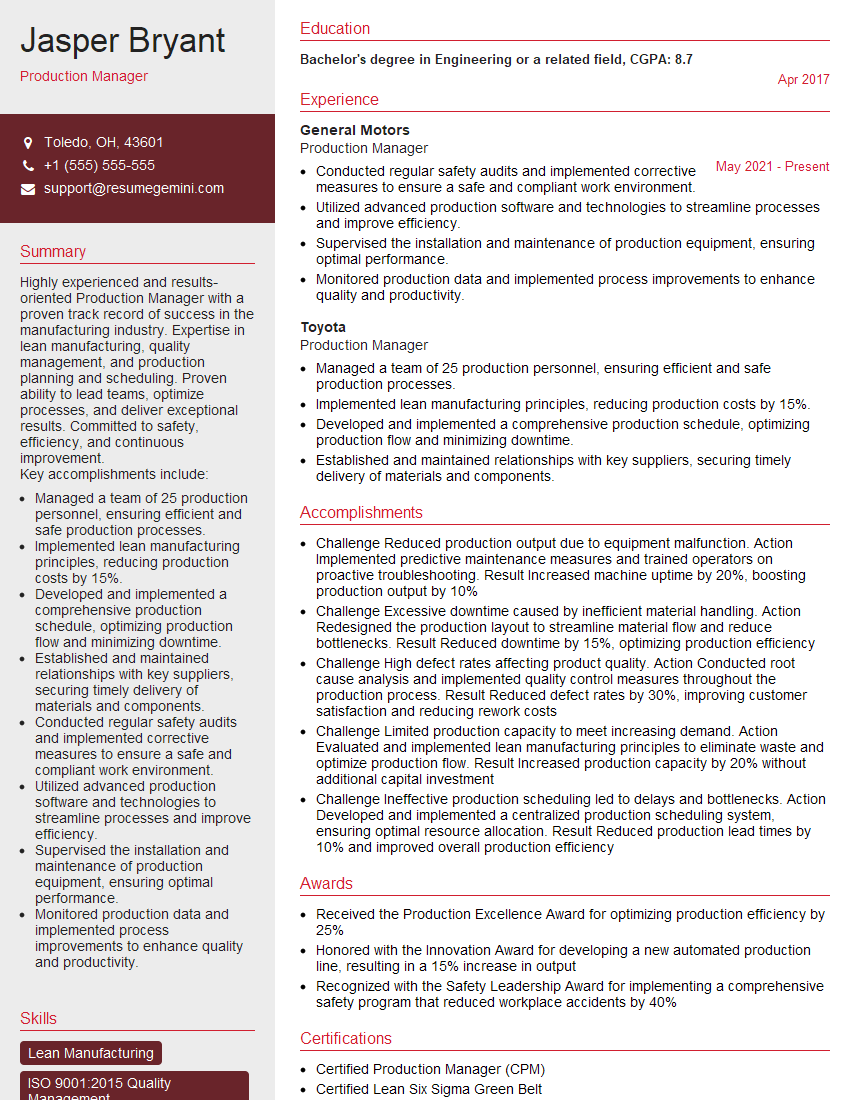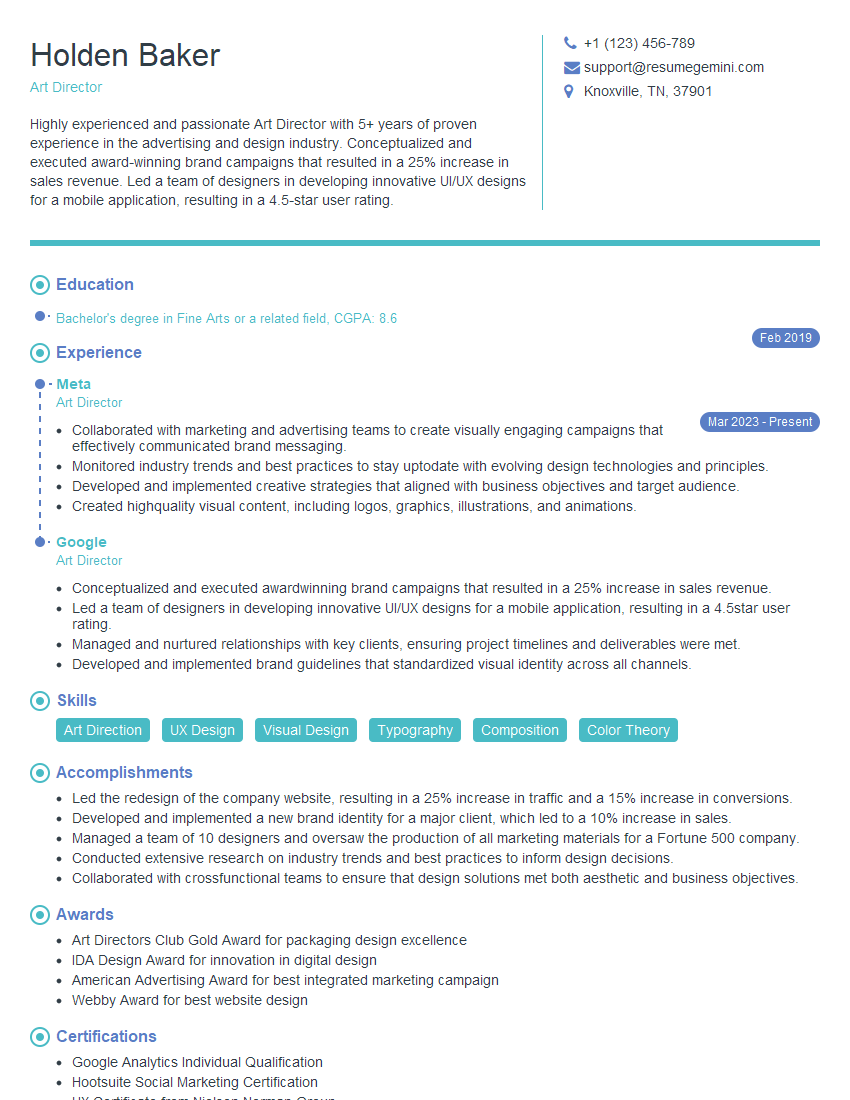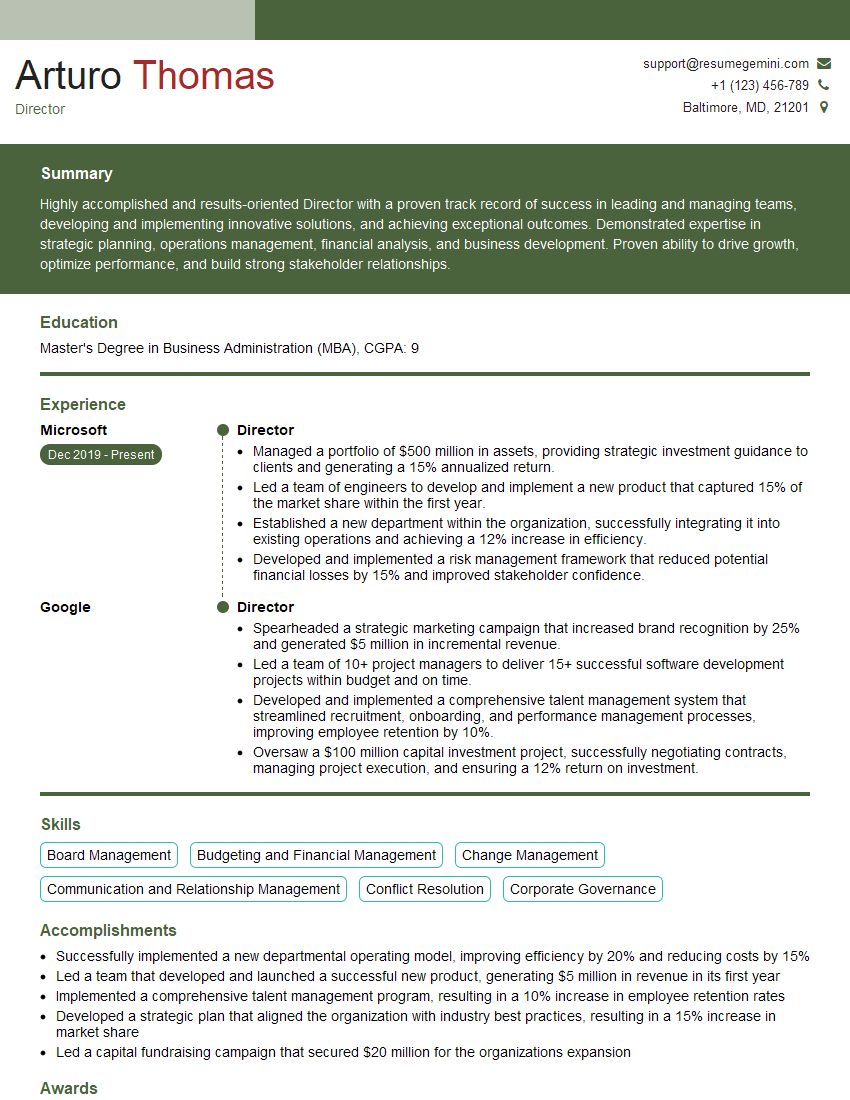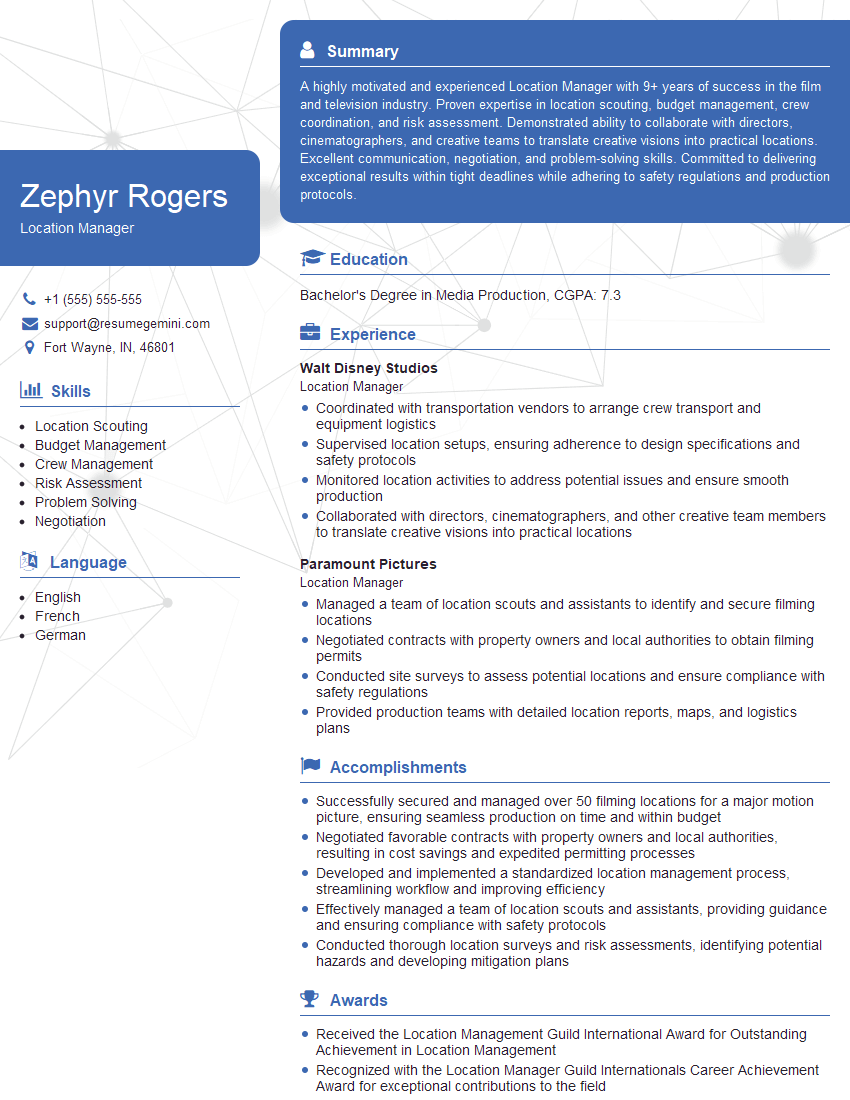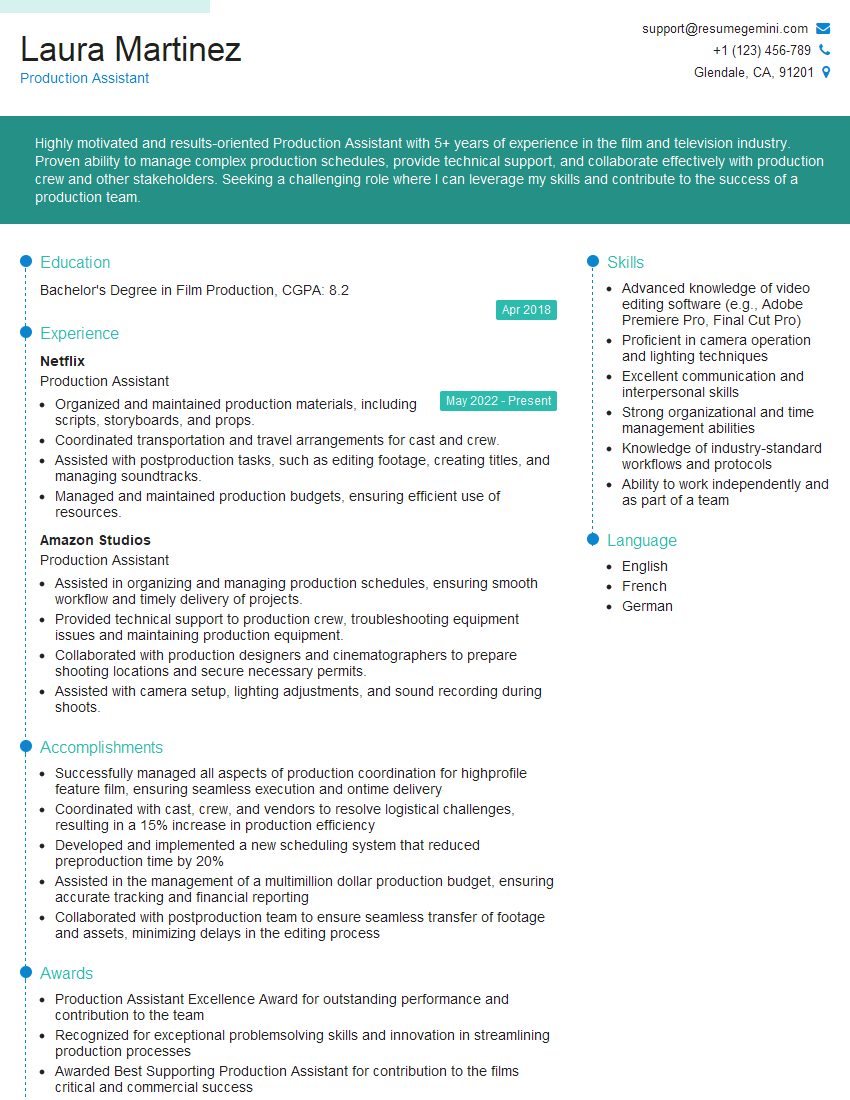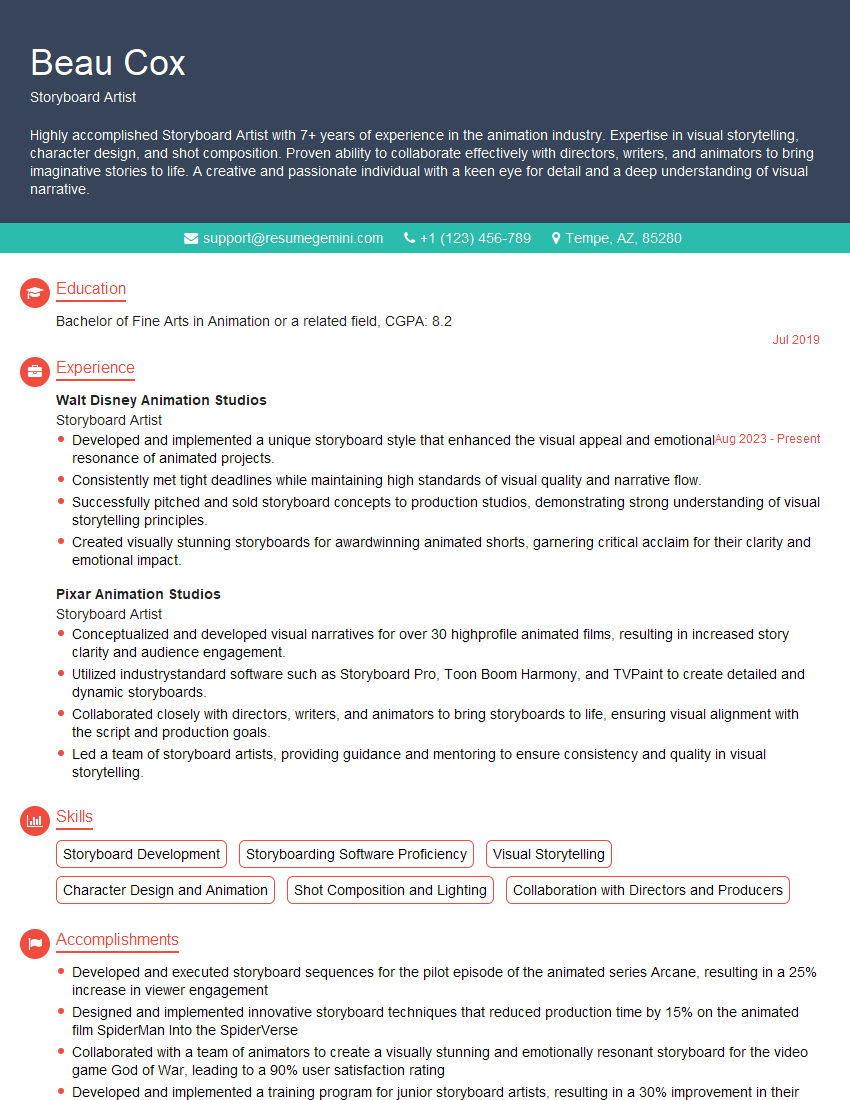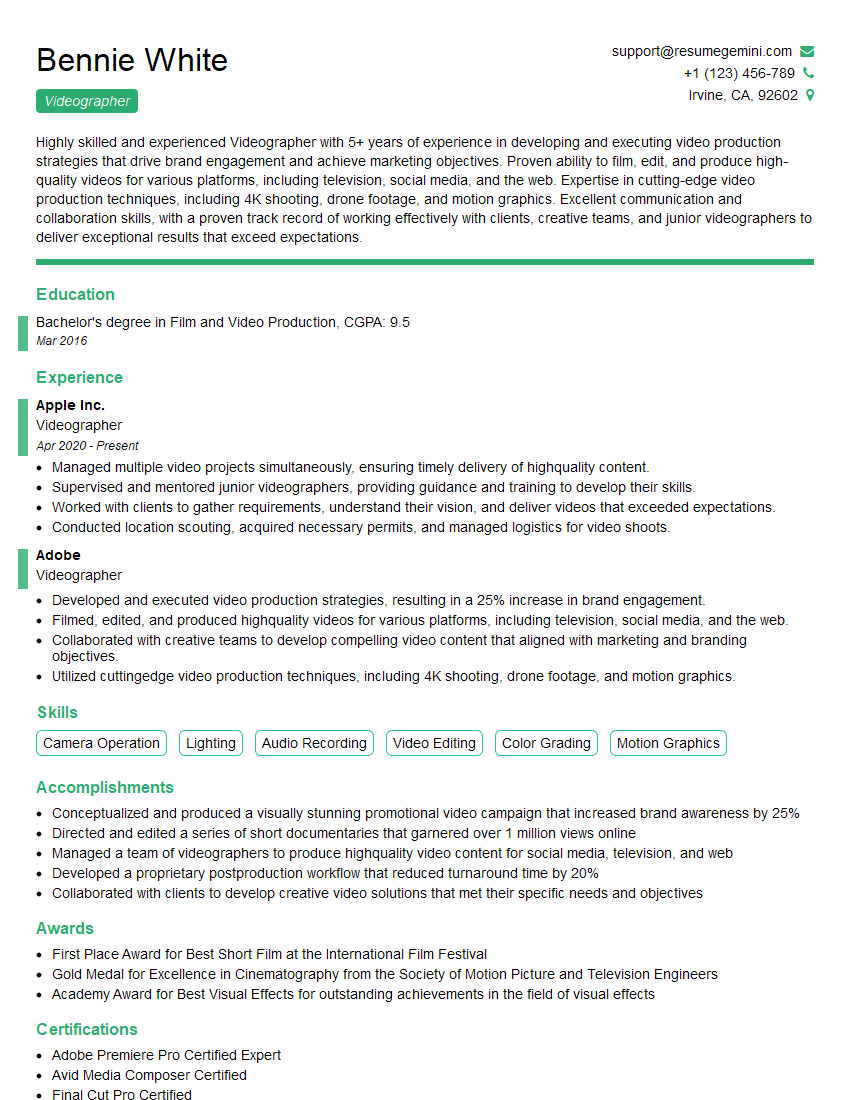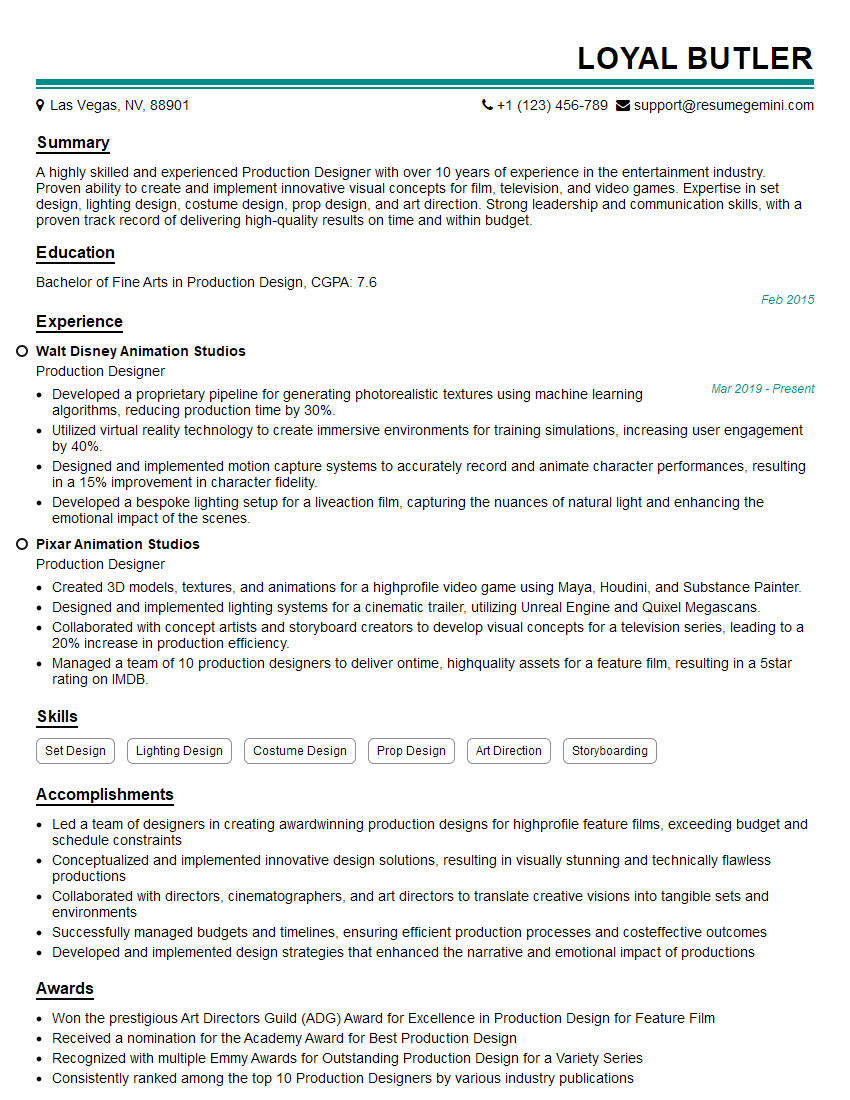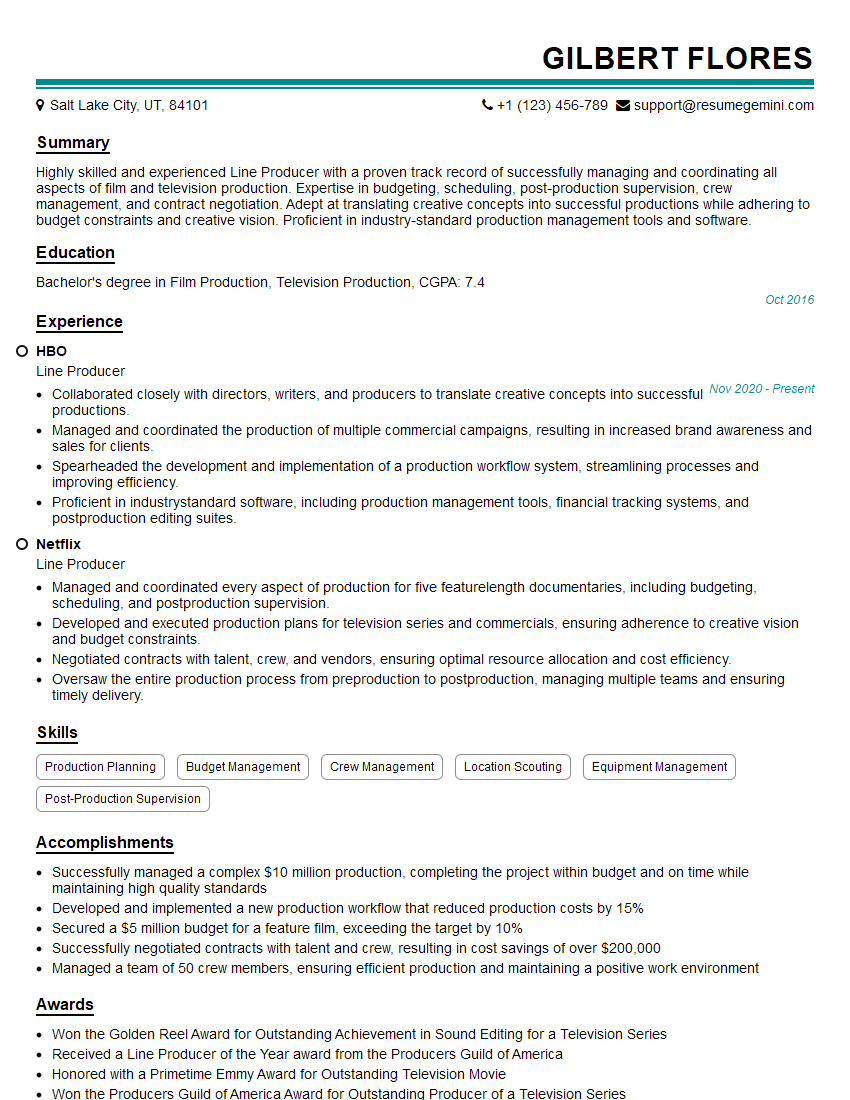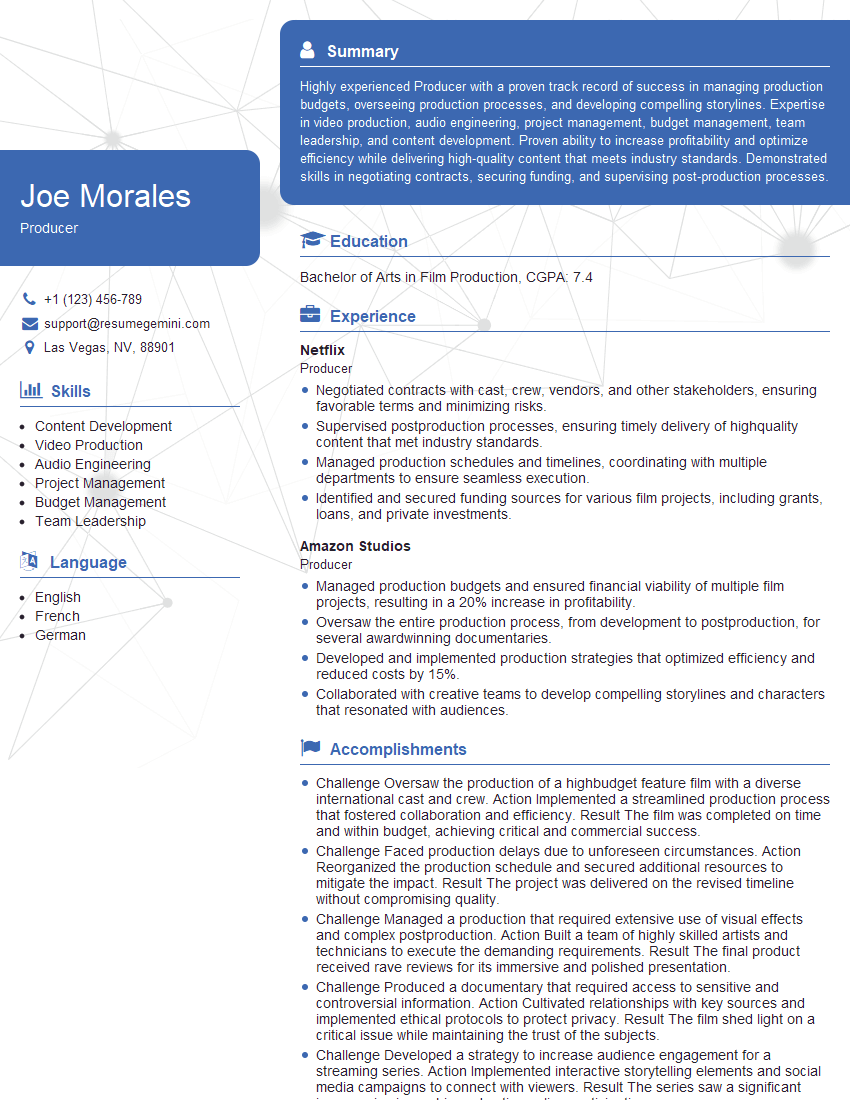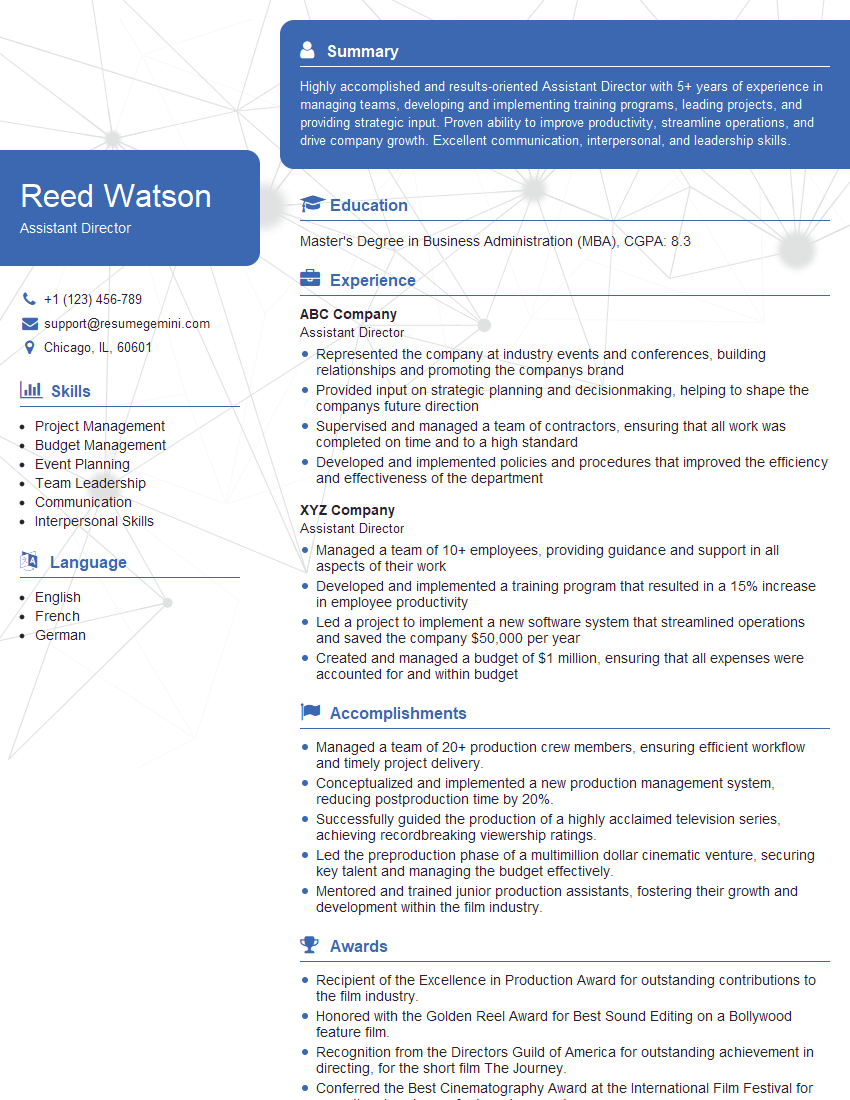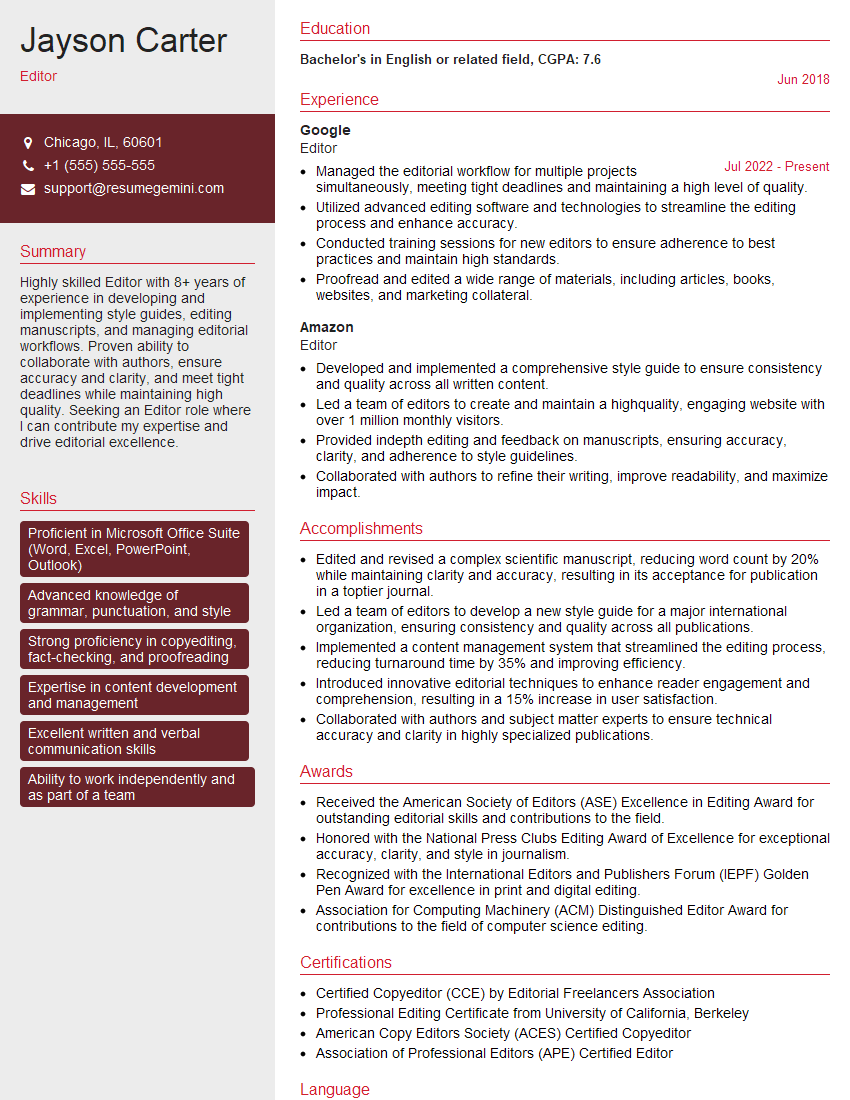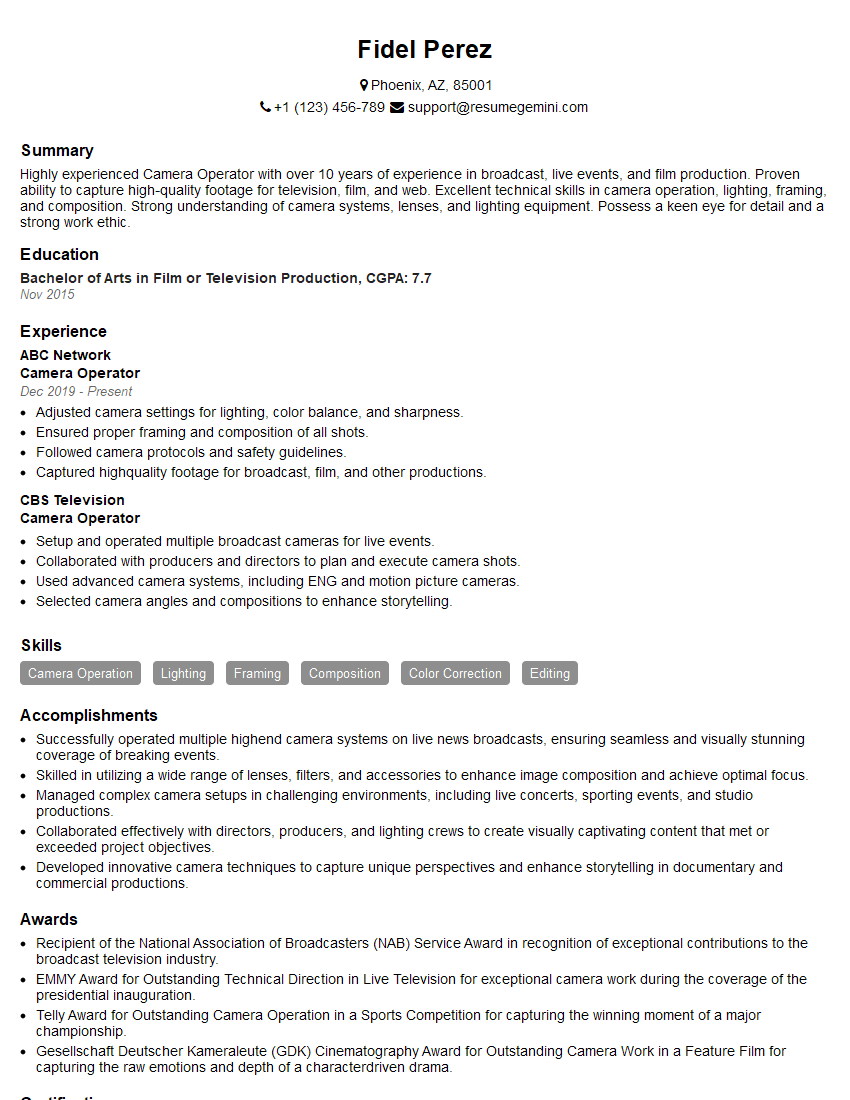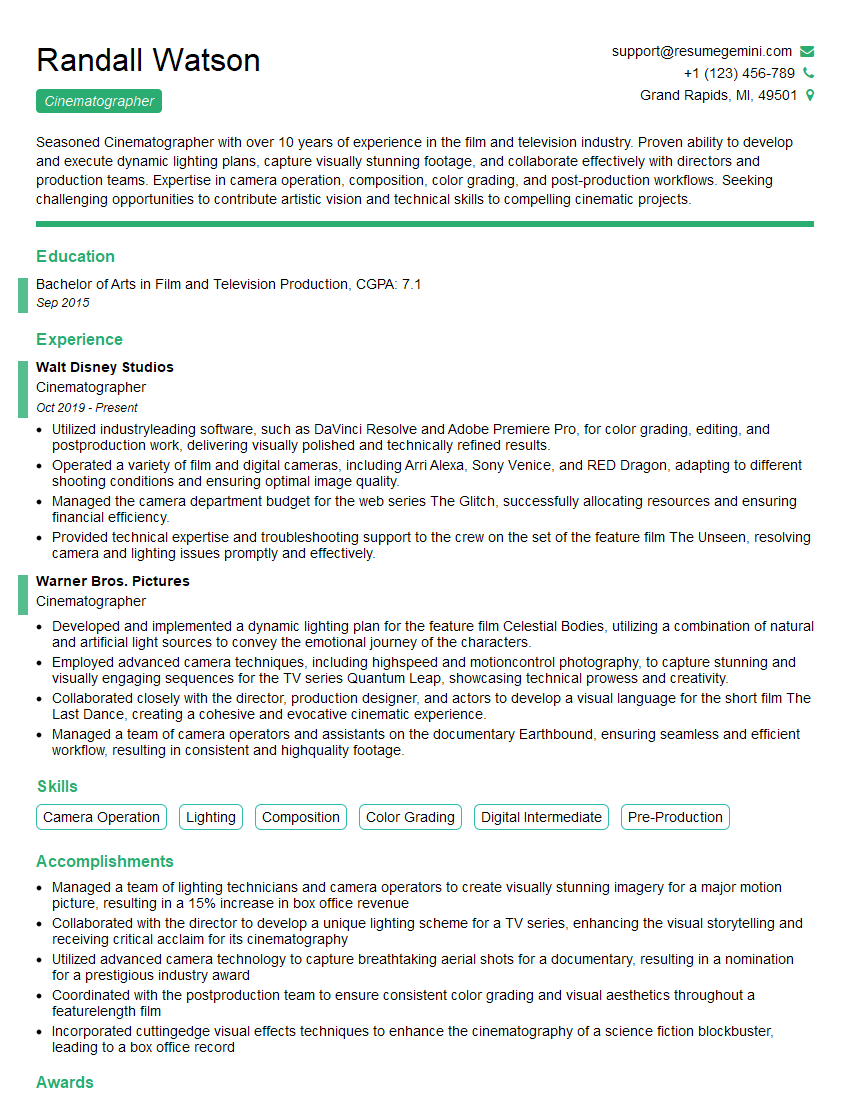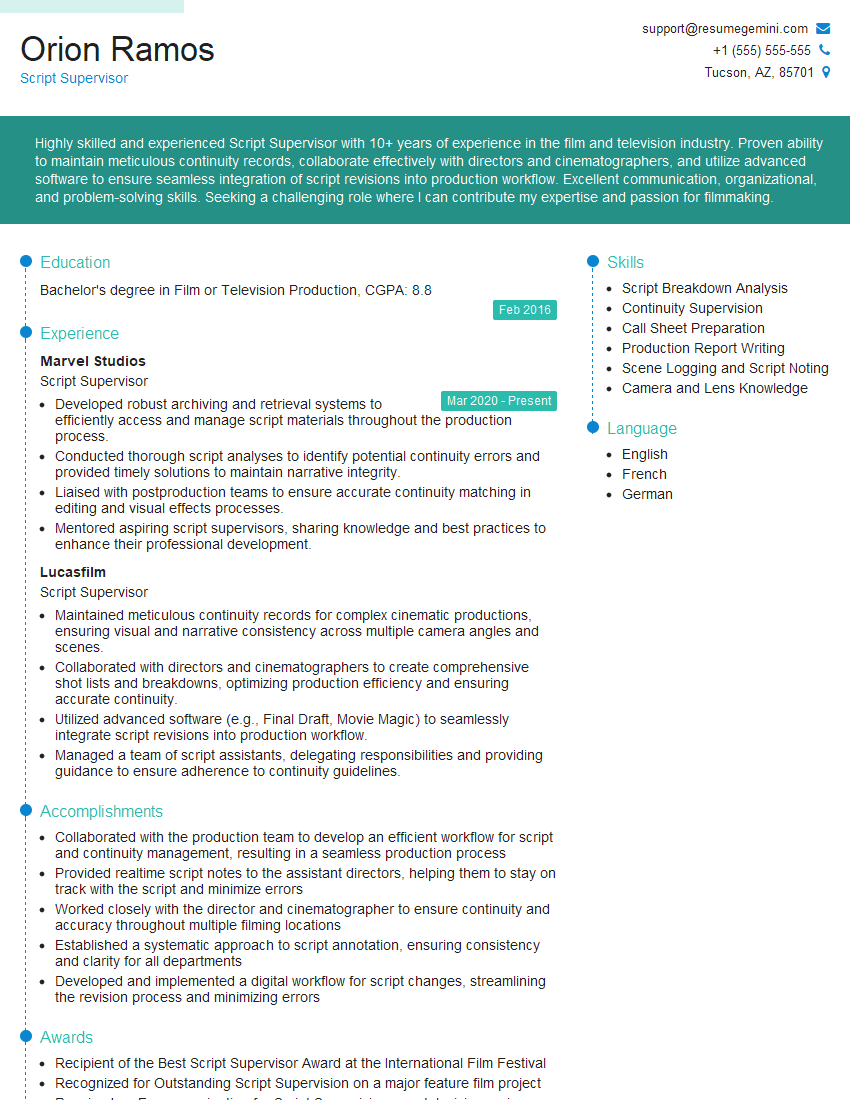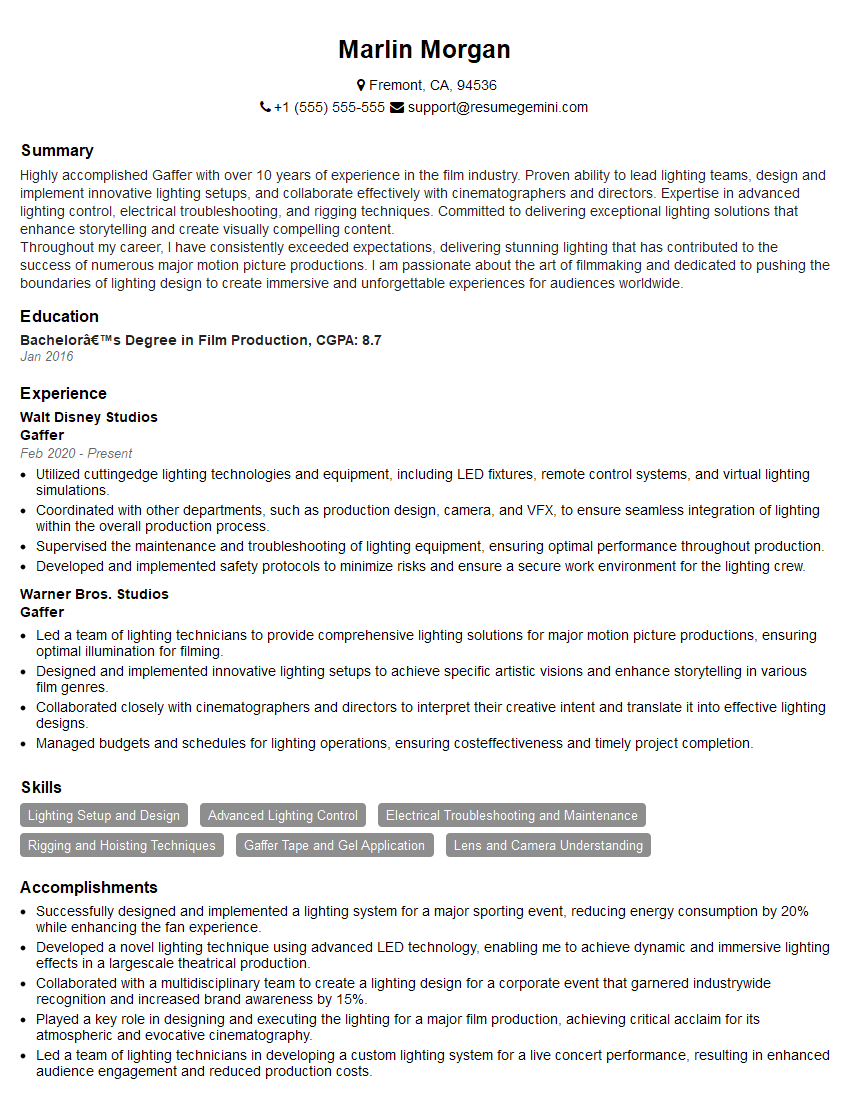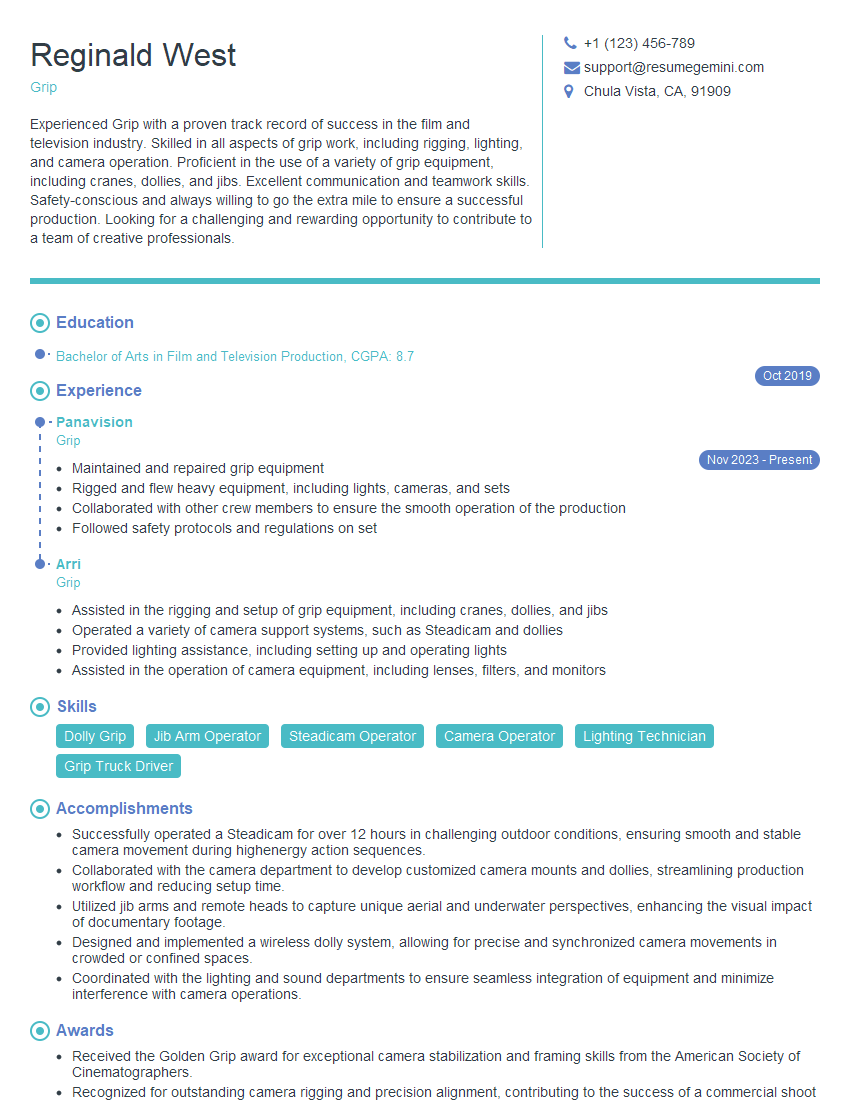Are you ready to stand out in your next interview? Understanding and preparing for Shot Listing interview questions is a game-changer. In this blog, we’ve compiled key questions and expert advice to help you showcase your skills with confidence and precision. Let’s get started on your journey to acing the interview.
Questions Asked in Shot Listing Interview
Q 1. What is a shot list and why is it crucial in filmmaking?
A shot list is a detailed document outlining every shot planned for a film or video production. It’s the filmmaker’s roadmap, specifying camera angles, movements, and other technical details for each scene. It’s crucial because it ensures consistent vision, optimizes shooting time, and facilitates communication between the director, cinematographer, and crew. Think of it as a recipe for a visual story – without it, you risk a chaotic and inefficient production.
For example, a scene might be described in the script as ‘Two characters argue in a cafe.’ The shot list would break this down into individual shots: a wide shot establishing the cafe’s ambiance, a medium shot focusing on the characters’ expressions, close-ups emphasizing their emotional reactions, etc. Without this breakdown, the scene’s execution would be haphazard and potentially miss key emotional beats.
Q 2. Explain the difference between a master shot and a coverage shot.
The master shot and coverage shots are fundamental components of a shot list. The master shot is a wide shot that captures the entire scene, providing context and establishing the spatial relationships between characters and elements within the scene. It’s your safety net – a complete record of the action. Coverage shots are then used to complement the master shot. These are closer shots, such as medium shots, close-ups, and over-the-shoulder shots, that focus on specific details and emotions, capturing the performances more intimately. They’re often used to enhance the storytelling and provide editorial flexibility during post-production.
Imagine filming a conversation. The master shot shows both actors seated at a table, establishing the setting. Coverage shots would include close-ups on each actor individually, catching subtle expressions during the dialogue. This combination allows for dynamic editing later, emphasizing the most impactful moments.
Q 3. How do you organize a shot list for optimal efficiency?
Organizing a shot list for optimal efficiency involves a structured approach. I prefer organizing by scene, then by shot type within each scene. This allows for logical sequencing during filming, minimizing camera setups and maximizing continuity. Each entry includes the scene number, shot number, shot description (including camera angle, movement, and framing), and any relevant notes about the action or desired mood. I also use clear numbering and descriptive labels for easy reference on set. Color-coding can further enhance organization, perhaps separating master shots, coverage, and inserts.
For instance, a section might look like this:
- Scene 3: Argument in the Cafe
- Shot 3.1: Wide shot – establishing shot of cafe interior
- Shot 3.2: Medium shot – both characters arguing
- Shot 3.3: Close-up – character A’s angry expression
- Shot 3.4: Over-the-shoulder shot – character B reacting
This structure ensures that all necessary shots are captured in a flow that makes sense for the scene and the overall project.
Q 4. What software or tools do you prefer for creating and managing shot lists?
While many tools exist, I favor Shot Lister for its simplicity and collaborative features. Other excellent options include Movie Magic Scheduling, which offers robust scheduling and budgeting tools alongside shot listing, and various spreadsheet programs like Excel or Google Sheets, though these require more manual input and organization. The key is selecting a tool that fits your workflow and production scale. A simple spreadsheet might be sufficient for smaller projects, while a dedicated shot listing app might be beneficial for larger, more complex productions.
Q 5. Describe your process for creating a shot list from a screenplay.
My process for creating a shot list from a screenplay starts with a thorough reading, visualizing the action, and understanding the scene’s emotional arc. I then break down each scene into individual shots, considering the story’s needs and the director’s vision. This involves identifying key moments, character interactions, and visual elements that need to be captured. I use the screenplay’s action lines and dialogue as a guide, but also incorporate my own creative input to ensure compelling visuals. I meticulously note each shot’s technical specifications such as camera angle, lens, movement, and framing. I regularly confer with the director to ensure alignment on the visual storytelling.
For example, if the screenplay reads ‘John stares out the window, contemplating his future,’ I would likely plan at least a medium shot showing John and the window, and a close-up capturing the complexity of his expression. Further shots might include an insert of something that triggers his thoughts or a POV shot from his perspective.
Q 6. How do you handle changes to the shot list during production?
Change is inevitable during production. To handle it effectively, I maintain a flexible approach. The shot list isn’t set in stone; it’s a living document. I use a version control system, whether digital or a simple notebook with revision notes, to track all modifications. When changes arise – perhaps an actor suggests a different line reading, or a location presents unforeseen challenges – I make the necessary adjustments, annotating the changes with dates and rationale. Clear communication with the director and crew is crucial to keep everyone informed and on the same page. A daily production meeting is key in managing these changes, ensuring everyone is aware of any updates or revised plans.
Q 7. How do you incorporate camera angles and movement into your shot list?
Camera angles and movement are integral aspects of the shot list. I specify them precisely for each shot using clear and consistent terminology. For angles, this might involve high angle, low angle, eye-level, Dutch angle, etc. Movement is detailed using terms like pan, tilt, zoom, dolly, tracking, crane, and steadicam shots, including their direction and speed. The shot list should also specify the lens to be used for each shot (wide, medium, telephoto) to ensure consistent look and feel across the project. Furthermore, I include notes regarding focus and depth of field to enhance the storytelling and impact.
For example, a shot description might read: ‘Shot 5.2: Medium shot – Dolly in on character A as they reveal a secret; low angle, emphasizing their power; 50mm lens, shallow depth of field to blur the background.’ This level of detail ensures the cinematographer precisely understands the intended visual effect.
Q 8. What are some common mistakes to avoid when creating a shot list?
Creating a shot list is crucial for efficient filmmaking, but common mistakes can derail the entire production. One frequent error is a lack of detail. A vague shot list leads to confusion and wasted time on set. For example, simply writing “wide shot of the park” is insufficient. Instead, specify the camera angle, the characters’ positions, and the desired mood. Another common pitfall is neglecting to account for practical considerations such as lighting, set changes, and actor availability. Ignoring these factors can result in scheduling conflicts and costly reshoots. Finally, failing to review and revise the shot list collaboratively with the director and crew before filming can lead to discrepancies and misinterpretations. Think of it like building a house – a poorly planned blueprint leads to a flawed structure.
- Insufficient detail: Instead of “Shot of John walking,” use “Medium shot of John walking towards the camera, slightly right of center, showing slight apprehension on his face.”
- Ignoring logistics: Account for lighting setup time, set changes, and potential weather delays.
- Lack of collaboration: Ensure the shot list reflects a shared understanding among the team.
Q 9. How do you ensure your shot list accurately reflects the director’s vision?
Accurately reflecting the director’s vision is paramount. This requires a deep understanding of the director’s style, storytelling approach, and overall artistic intent. Before drafting the shot list, I engage in extensive pre-production discussions with the director, reviewing the script, storyboards, and any visual references. I ask clarifying questions to ensure I understand the nuances of each scene and the desired emotional impact. I actively listen to their feedback during the creation process and use visual aids like storyboards or even rough sketches to clarify ambiguities. Once a draft is completed, I present it to the director for review and incorporate their feedback iteratively until it perfectly captures their vision. It’s a collaborative process, not a dictation.
For instance, if the director wants a specific feeling of isolation in a scene, I would ensure the shot choices – perhaps extreme long shots or use of negative space – reflect that. Regular check-ins throughout the process are key.
Q 10. How do you collaborate with the director and other crew members to finalize the shot list?
Collaboration is the cornerstone of a successful shot list. I begin by sharing a preliminary draft with the director and key crew members – the cinematographer, 1st AD, and production designer. We conduct a thorough review, using a shared online document or meeting to discuss each shot. This allows for immediate feedback and adjustments. The cinematographer’s expertise is crucial for assessing the technical feasibility and visual aspects of the shots. The 1st AD provides crucial logistical input regarding scheduling and resource allocation. The production designer contributes their insights on set design and prop placement to ensure the shots align with the overall aesthetic.
This collaborative process allows us to identify potential challenges early on and make necessary revisions before filming begins. Think of it as a team brainstorming session to optimize efficiency and creative success. I use a system of version control to keep track of all changes and ensure everyone is working with the latest iteration.
Q 11. Explain your experience with different types of shot lists (e.g., detailed, concise).
My experience encompasses both detailed and concise shot lists. Detailed shot lists are invaluable for complex productions with extensive visual effects or intricate action sequences. They include information such as camera movement, lens choice, framing specifics, and even special instructions for the camera operator. These lists might resemble a technical script, providing a comprehensive guide for every aspect of the shot. Concise shot lists are more suitable for simpler projects or quick turnaround productions. They provide a summary of the key shots, focusing on essential elements and omitting redundant details. The choice depends entirely on the project’s scale and complexity.
Example of a detailed entry:Shot 12: EXT. FOREST - DAY
Wide shot (16mm lens). Dolly in on Emily walking through the forest. Camera moves from slightly below eye-level to eye-level as she approaches a clearing. Use a slow, deliberate dolly movement. Slightly diffused sunlight.
Example of a concise entry:Shot 12: WS Emily walking through forest.
Q 12. How do you estimate the time required for each shot in your shot list?
Estimating shot time requires experience and understanding of filmmaking logistics. It’s not just about the duration of the shot itself, but also the time needed for setup, rehearsal, and potential takes. I base my estimations on several factors: the complexity of the shot (camera movement, lighting, special effects), the number of actors involved, and the required takes. For simple shots, I might allocate 15-20 minutes. For complex shots involving elaborate setups and multiple actors, I may allocate several hours. I use a spreadsheet that allows me to track the estimated time for each shot and calculate the total shooting time, helping to create a realistic production schedule. Contingency time is always factored in to account for unexpected delays.
It’s crucial to be realistic in these estimations; underestimating can create huge problems on set. I often consult with the 1st AD to ensure the shot timings are consistent with the overall production schedule.
Q 13. How do you factor in lighting, set design, and props into your shot list?
Lighting, set design, and props are integral components of the shot list and must be factored in meticulously. I work closely with the cinematographer, production designer, and prop master to ensure the shot list aligns with the overall visual design. The shot list must specify the lighting scheme, detailing key light, fill light, and back light sources. It should also describe the set dressing, prop placement, and the specific requirements for the scene. I use descriptions and possibly visual references (like a set design drawing) to ensure everyone is on the same page. For example, specifying “soft, diffused light from the left” helps illuminate the scene’s mood and aesthetic.
By detailing these aspects, we avoid on-set surprises and ensure that every shot looks exactly as envisioned, saving time and resources. I would include descriptions such as, “Close-up on the antique clock, lit with Rembrandt lighting, showing dust particles in the beam.” Detailed descriptions minimize ambiguity.
Q 14. How do you handle shots that require special effects or visual effects?
Shots requiring special or visual effects (SFX/ VFX) necessitate a more detailed and nuanced approach. I collaborate closely with the VFX supervisor to identify the specific VFX needs for each shot. This involves documenting the required elements – e.g., explosions, CGI characters, or digital environment enhancements – and any specific requirements or limitations. The shot list includes placeholders for these effects, clearly indicating where and how they will be integrated. For example, I might note “Shot 15: Wide shot of the spaceship explosion (VFX to be added in post-production). Camera angle: slightly high, looking down.”
Additionally, I would collaborate with the VFX team to create storyboards or pre-visualization to better understand the final look of the shots and ensure that the live-action footage is correctly captured. I also include detailed notes on markers and reference points for the VFX artists to accurately integrate the effects.
Q 15. Describe your process for reviewing and revising a shot list.
Reviewing and revising a shot list is an iterative process that ensures the final product aligns with the director’s vision and is feasible on set. My process begins with a thorough read-through of the script, identifying key moments and emotional beats that need visual emphasis. I then create a preliminary shot list, considering factors like camera angles, movement, and lens choices. This initial draft is then discussed with the director to refine the vision.
The revision phase involves several steps:
- Scene Breakdown: Analyzing each scene individually, ensuring each shot contributes to the overall narrative and emotional impact.
- Technical Feasibility: Evaluating the practicality of each shot, considering factors like location limitations, available equipment, and time constraints. This might involve suggesting alternative shots that achieve a similar effect more efficiently.
- Visual Storytelling: Ensuring the shot list effectively communicates the story through visual language. This involves considering shot composition, camera movement, and the relationship between shots in a sequence.
- Collaboration: Collaborating closely with the director of photography (DP) to ensure the shot list is technically sound and artistically compelling. This includes discussing camera angles, lighting, and other technical aspects.
- Finalization: The final revision incorporates feedback from all stakeholders, resulting in a clear, concise, and executable shot list.
For example, if a scene initially called for a complex crane shot that would be logistically difficult and time-consuming, we might explore a more practical alternative using a Steadicam or hand-held shots to achieve a similar effect.
Career Expert Tips:
- Ace those interviews! Prepare effectively by reviewing the Top 50 Most Common Interview Questions on ResumeGemini.
- Navigate your job search with confidence! Explore a wide range of Career Tips on ResumeGemini. Learn about common challenges and recommendations to overcome them.
- Craft the perfect resume! Master the Art of Resume Writing with ResumeGemini’s guide. Showcase your unique qualifications and achievements effectively.
- Don’t miss out on holiday savings! Build your dream resume with ResumeGemini’s ATS optimized templates.
Q 16. What is your experience with shot listing for different genres of film?
My experience spans various film genres, and shot listing adapts significantly depending on the style and pacing.
- Action Films: Require fast-paced, dynamic shots, often using quick cuts and handheld cameras. The shot list needs to prioritize action clarity and dramatic impact, often including a lot of close-ups and reaction shots.
- Dramas: Emphasize character development and emotional nuance. Shot lists often feature longer takes, carefully composed shots, and a deliberate pace to allow for emotional connection. The focus is on subtle details and expressions.
- Comedies: Shot lists will prioritize visual gags and comedic timing. They often include many reaction shots and creative camera angles to enhance the humor.
- Documentaries: Shot lists are less rigid, allowing for more spontaneity and improvisation on set. However, a basic structure outlining key interviews, locations and events needs to be in place. They prioritize capturing authentic moments and natural behavior.
- Horror Films: Often use creative camera angles and lighting to build suspense and terror. Shot lists may include POV shots, close-ups on disturbing details, and strategic use of shadows to create a chilling atmosphere.
In each case, the shot list serves as a roadmap that allows for efficient and creative filmmaking while ensuring consistency in the storytelling.
Q 17. How do you maintain accuracy and consistency in your shot lists?
Maintaining accuracy and consistency in shot lists is crucial for efficient production. I achieve this through:
- Detailed Script Breakdown: A thorough breakdown of the script is essential to accurately represent the scene’s action and dialogue in the shot list.
- Clear Shot Descriptions: Using precise language to describe each shot, including camera angles (e.g., wide shot, medium shot, close-up), camera movement (e.g., pan, tilt, zoom), and lens choices. Examples:
[SCENE 1, SHOT 1: Wide shot, establishing shot of the house.],[SCENE 1, SHOT 2: Medium shot, character A enters the house, apprehensive expression.] - Version Control: Using version control software or a clear system for tracking revisions, ensuring everyone has access to the latest version.
- Regular Check-ins: Regular meetings with the director and DP to review and approve the shot list before production.
- On-set Consistency: Close collaboration with the DP on set to ensure the shots are executed as planned. On-set adjustments might necessitate updating the shot list, which should be done immediately and communicated to relevant crew members.
This meticulous approach minimizes discrepancies and ensures a seamless workflow from pre-production to post-production.
Q 18. Describe your proficiency in using shot listing software or applications.
I’m proficient in several shot listing software applications, including Shot Designer, StudioBinder, and Movie Magic Scheduling. My experience extends beyond simply inputting data; I understand how to leverage these tools to their full potential, streamlining the collaboration process, managing revisions effectively, and ensuring all relevant information is readily available.
For instance, in Shot Designer, I can efficiently link shots to specific storyboard panels, creating a visual representation of the scene flow. This visual element is particularly helpful for communication with the crew. In StudioBinder, I leverage its capabilities to assign shots to crew members, ensuring clear responsibilities and task management. My experience allows me to select and tailor the software to the specific needs of each project.
Q 19. How do you ensure your shot list is accessible and understandable to the entire crew?
Accessibility and understandability are paramount. I ensure the shot list is user-friendly for the entire crew by using a clear and concise format.
- Clear and Concise Language: Avoiding technical jargon unless absolutely necessary, using plain language that everyone can understand.
- Visual Aids: Incorporating visual aids like storyboards or simple sketches alongside shot descriptions to provide additional clarity.
- Consistent Formatting: Employing a consistent and easily readable format, ensuring that information is organized logically and readily accessible.
- Distribution Method: Using a digital platform that enables easy access and sharing (e.g., cloud storage, shared document platforms) and ensuring the latest version is always available.
- Pre-Production Meetings: Conducting pre-production meetings to walk through the shot list with the crew, answering any questions and ensuring everyone is on the same page.
Think of it like a well-written recipe: clear instructions, consistent measurements, and easy-to-follow steps ensure a successful outcome, whether you’re baking a cake or making a film.
Q 20. Explain your approach to managing a complex and lengthy shot list.
Managing complex and lengthy shot lists requires a structured approach. My strategy involves breaking down the larger project into manageable chunks.
- Scene-by-Scene Breakdown: Dividing the shot list into scenes, focusing on each individually before moving on to the next. This allows for detailed planning and prevents feeling overwhelmed.
- Shot Grouping: Grouping shots by location or setup to optimize shooting schedules and minimize transitions. This improves efficiency and reduces downtime.
- Color-coding or Tagging: Using color-coding or tagging within the shot list software to categorize shots based on various criteria (e.g., camera angles, special effects, lighting). This aids in visual organization and quick reference.
- Digital Tools: Leveraging the features of shot list software to create reports, summaries, and schedules.
- Regular Updates: Keeping the shot list updated throughout the process to reflect any changes or additions. This ensures everyone has access to the latest information.
This segmented approach allows for more manageable workflow, preventing feeling overwhelmed and enhancing focus on individual sections.
Q 21. How do you deal with unexpected changes or challenges on set that affect the shot list?
Unexpected changes on set are inevitable. My approach focuses on adaptability and quick problem-solving.
- On-set Assessment: Quickly assessing the situation and determining the impact on the shot list. This requires clear communication with the director and DP.
- Alternative Solutions: Developing alternative shots or sequences that achieve similar results, while maintaining narrative flow and visual consistency.
- Immediate Communication: Communicating the changes to the relevant crew members promptly, ensuring everyone is informed and on the same page.
- Shot List Update: Updating the shot list to reflect the changes, maintaining accuracy and consistency.
- Contingency Planning: Having a contingency plan in place to address potential challenges. This often involves having backup shots or alternative locations identified beforehand.
For instance, if a crucial location becomes unavailable due to unforeseen circumstances, having a backup location scouted beforehand would allow for a seamless transition. This preparedness minimizes disruptions and keeps the production on track.
Q 22. How do you prioritize shots based on factors like time constraints and resources?
Prioritizing shots under time and resource constraints requires a strategic approach. I start by identifying the most crucial scenes and shots that drive the narrative. These are often the ones that convey the core emotional beats or pivotal plot points. Think of it like building a house: you wouldn’t start with the trim before laying the foundation.
I then categorize shots based on complexity and resource needs. High-complexity shots requiring specialized equipment or large crews are scheduled for times when those resources are most readily available. Simple shots, often coverage shots, can often fill in gaps in the schedule. A spreadsheet is invaluable here – I’ll list each shot, its estimated time, the resources needed (crew, equipment, location), and then prioritize based on these factors. This helps identify potential bottlenecks early on, allowing for adjustments to the schedule or shot list itself.
For example, a complex crane shot might be prioritized for the morning when lighting is ideal, whereas simpler close-ups can be shot later in the day, regardless of lighting conditions. This prioritization ensures efficient use of resources and minimizes delays.
Q 23. How do you integrate the shot list with other pre-production documents?
The shot list is a crucial component of pre-production, deeply intertwined with other documents. It directly informs the call sheet (which details the daily shooting schedule), the storyboard (which visually outlines the shots), and the production schedule (which sets overall timelines and budgets). The script itself is, of course, the ultimate source.
Often, I’ll use a software like ShotGrid or even a well-organized spreadsheet to link these documents. For example, each shot in the shot list will have a corresponding storyboard panel, a script page reference, and an assigned time slot in the production schedule. This interconnectedness ensures everyone is on the same page and any changes to one document are readily reflected in others. The continuity between these documents is critical for a smooth production process.
Q 24. What strategies do you employ to ensure the shot list remains current and up-to-date?
Keeping the shot list current is paramount. I utilize a collaborative platform (like Google Sheets or a dedicated production management software) that allows for real-time updates and version control. This means any changes, whether from directorial adjustments, location scouting revisions, or equipment availability issues, can be immediately incorporated.
Regular check-ins with the director and director of photography are essential. Daily reviews of the previous day’s shoot and any adjustments needed to the remaining shots are conducted. I always maintain a detailed log of changes, documenting the reasons for revisions. This maintains transparency and accountability, ensuring everyone is aware of any adjustments made to the original plan. Finally, having a clear communication system in place for updates helps keep the entire team informed.
Q 25. Describe your experience with shot list revisions and approvals.
Shot list revisions are a normal part of filmmaking. My experience includes working collaboratively with directors and cinematographers to refine the list based on creative feedback and practical limitations. This usually involves multiple rounds of revisions, with annotations and notes accompanying each change.
I’ve used various methods for approval, from simple email chains with tracked changes to dedicated software platforms. The key is to have a clear process for tracking feedback and ensuring everyone’s input is considered. Ultimately, a finalized approved version is crucial to avoid confusion and ensure the entire crew is working from the same information. I always maintain a history of revisions, allowing for easy tracking and reference.
Q 26. How familiar are you with different shot sizes and their purpose?
I’m very familiar with shot sizes and their purpose. Understanding shot sizing is essential for visual storytelling. Each shot size conveys a different emotional impact and informs the audience’s perspective.
- Extreme Wide Shot (EWS): Establishes the setting and environment, often used for establishing shots.
- Wide Shot (WS): Shows the character within their environment, providing context.
- Medium Wide Shot (MWS): Shows the character from the knees up, balancing environment and character focus.
- Medium Shot (MS): Shows the character from the waist up, more intimate than wider shots.
- Medium Close-Up (MCU): Shows the character from the chest up, focusing on their facial expressions and upper body language.
- Close-Up (CU): Shows a character’s face, highlighting emotion and detail.
- Extreme Close-Up (ECU): Shows a specific detail, like an eye or a hand, emphasizing a specific aspect.
The purpose is to vary shot sizes to create dynamic visual pacing and emotional impact. Switching between wide shots and close-ups keeps the audience engaged while providing necessary context and intimacy.
Q 27. How do you utilize shot lists to maintain continuity between scenes and takes?
The shot list is instrumental in maintaining continuity between scenes and takes. I ensure that each shot is clearly labeled and numbered, along with scene and take information. This allows for accurate logging and referencing during the shoot and during post-production editing.
Furthermore, I often include notes in the shot list regarding key elements to be maintained for continuity – actor positions, prop placement, and lighting. Before commencing each shot, I verify that these elements align with the previous shot, effectively bridging the visual narrative. The shot list becomes a detailed roadmap ensuring the flow of the story remains seamless.
Q 28. How do you incorporate special equipment requirements into your shot list?
Special equipment requirements are integrated directly into the shot list. For each shot that requires specialized gear (cranes, Steadicams, specialized lenses, etc.), I include a column specifically for this information. This column specifies the type of equipment, its availability, and any potential logistical considerations.
This ensures that the crew is aware of the equipment needs in advance. It allows for proper scheduling and acquisition of the equipment, preventing delays or disruptions due to missing or unavailable items. In addition, I collaborate with the equipment manager to ensure all necessary gear is procured and properly tested before the shoot.
For instance, if a shot requires a drone, I would specify the drone model, the pilot’s availability, any necessary permits, and potential weather considerations. This comprehensive approach guarantees a seamless workflow and minimizes unforeseen complications.
Key Topics to Learn for Shot Listing Interview
- Understanding Shot Types: Mastering the terminology and visual characteristics of various shot types (e.g., wide shot, medium shot, close-up, extreme close-up, etc.) and their impact on storytelling.
- Shot Composition and Framing: Learn the principles of effective composition, including rule of thirds, leading lines, and headroom/noseroom, to create visually appealing and impactful shots.
- Shot Sequencing and Continuity: Understand how shots are arranged to create a coherent narrative, maintaining continuity of action and visual flow. Practice analyzing existing sequences to identify techniques used.
- Camera Angles and Movement: Explore the expressive power of different camera angles (high angle, low angle, eye level) and movements (pan, tilt, zoom, tracking shot) and their effect on mood and storytelling.
- Shot Listing and Storyboarding: Develop a strong understanding of how to create a clear and concise shot list, potentially incorporating storyboarding techniques to visually plan sequences.
- Practical Application: Practice creating shot lists for different scenarios, such as a simple dialogue scene, an action sequence, or a establishing shot. Analyze how different choices affect the final product.
- Problem-Solving: Consider challenges like limited resources, time constraints, or unexpected on-set issues and how to adapt your shot list accordingly. Develop creative solutions while adhering to the overall vision.
Next Steps
Mastering shot listing is crucial for career advancement in film, video production, and related fields. A strong understanding of visual storytelling and planning significantly enhances your value to any production team. To maximize your job prospects, create an ATS-friendly resume that highlights your skills and experience effectively. ResumeGemini is a trusted resource to help you build a professional and impactful resume tailored to your specific career goals. Examples of resumes tailored to Shot Listing are available to help you get started.
Explore more articles
Users Rating of Our Blogs
Share Your Experience
We value your feedback! Please rate our content and share your thoughts (optional).
